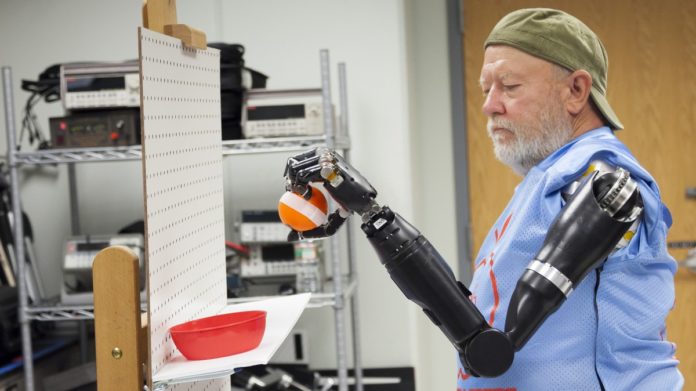Double amputee controls bionic arms with his mind
Prosthetic technology has made huge leaps in recent years, but the Johns Hopkins University Applied Physics Laboratory is pushing it into Six Million Dollar Man territory.
Scientists recently equipped double amputee Les Baugh with a pair of Modular Prosthetics Limbs (MPL) that he controls with his mind.
But it wasn’t easy for Baugh, a Colorado man who lost both arms in an electrical accident nearly 40 years ago. Surgeons at Johns Hopkins essentially had to wake up dead nerves, and reassign others in Baugh’s chest, so he could control the arms through his nerves. The process of “re-enverating” was, as Baugh said in the above video, quite painful.
Currently in a prototype phase, the bionic arms were attached to a special harness that uses pattern recognition to observe muscle activity generated by the re-awakened nerves. It then translates the activity into impulses that move the fully articulated arms and hands. According to researchers, they provide Baugh with 30 degrees of motion on both sides.
To build Baugh’s special body brace or socket, Johns Hopkins’ APL team took a 3D scan of his torso. However, scientists were not satisfied with the resulting cast, and redid it the old-fashioned way, using a model made from a plaster cast applied directly to Baugh’s body.
What’s more, Baugh had to learn to control the arms with his mind, which he did in a virtual-reality environment. It recreated the arms on screen, and then enabled Baugh to control them via thought.
When he started using the arms last June, Baugh impressed researchers. “What really was amazing, and was another major milestone with MPL control, was his ability to control a combination of motions across both arms at the same time. This was a first for simultaneous bimanual control,” the APL’s Courtney Moran said in a release.

Baugh completes a task showcasing his control of the MPL.
Image: The Johns Hopkins University Applied Physics Laboratory
For his part, Baugh “went into a whole different world,” he said in the video. He then successfully performed a number of task with his new arms, including moving cups on a shelf.
Still, movement and control are not as effortless as with real arms. To move an arm, Baugh has to first move his shoulder, then elbow, then wrist and then hand, while taking a short rest in between each movement.
“I think we are just getting started. It’s like the early days of the Internet … the next five to 10 years are going to bring phenomenal advancement,” the APL’s principal investigator Michael McLoughlin said.
The arms are still in development, but the Johns Hopkins team hopes to eventually send Baugh home with a pair.
Have something to add to this story? Share it in the comments.
